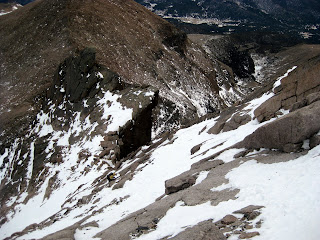On Saturday evening, the two of us backpacked up to treeline at about 11,000 feet on the Longs Peak trail (stupidly popular in the summertime, and well-traveled in the winter up to where we camped). We set up camp, melted snow for water, ate dinner, and went to bed early in preparation for a long day. The weather was moderately windy (20 mph sustained) all night but otherwise relatively warm (18 degrees) considering our location and the time of year. I experimented by bringing my ultralight summer bag rated to +45 degrees with the intention of wearing my insulated synthetic pants (thanks Al and Karen) and my synthetic parka inside of it. This worked really well and saved about 3 pounds in my pack. I think I could go down to about 10 degrees with this system. All this rambling and I haven't even gotten to the climb yet . . .
After two failed watch alarms, we got up at 6:15 and were on the trail by 6:45. We hiked up the sparsely snow-covered trail for about 3 miles along the standard Keyhole Route trail until we got to the Boulder Field. Up above treeline, the winds were sustained on the order of 25-30 mph for the duration of our climb. At the Boulder Field our path diverged from the standard route and we climbed a steepening face towards the edge of the Diamond.

The route route follows the green dots (you'll need to double click on the picture to see them). The red dots mark the beginning and end of the technical pitch.
About 500 feet below the summit, a near-vertical step of about 150 feet bars the way. In years past, the National Park Service strung a cable up this section and it was the most popular route up the mountain. Since that time, the cable has been removed and all but 4 of the bolts cut that held it in place. Using the remaining bolts as well as a few additional pieces of protection, I led the technical pitch and Heather followed. It turned out to be much easier than reports had suggested. The mixed snow/ice/rock nature of the climb made it particularly interesting. I opted to climb it with an ice axe in my right hand and a gloved left hand, which ended up working very well.

Approaching the base of the climb
Above the technical pitch lies a few hundred vertical feet of leftward traversing to the summit. This section is class 4, meaning that it is somewhat steep and tricky but does not necessitate the use of a rope. However, the fact that an un-arrested fall would lead to a slide over the Diamond (an approximately 2000 foot vertical face) makes the use of a rope a serious consideration. Heather and I both decided that we felt comfortable enough on the terrain that we would climb the final bit unroped.

Heather above the technical pitch - or rather - above the Diamond
We reached the summit at about 12:45, 6 hours after leaving the tent.

Summit mug shot
We descended the same route, retracing our steps at the technical section in 2 rappels.

Heather rappelling down the technical pitch
We retrieved some water that we cached near the bottom of the climb and began a long slog back to our tent. We quickly packed up at the tent and continued back to the trailhead, arriving just as it got dark. Although we were hiking/climbing for about 11 hours, the nature of a steep north face route in the winter meant that we were in the sun for a total of about 15 minutes.
For anyone reading this looking for route beta, I offer the following. A 50-meter rope is enough to climb the technical section in a single pitch and descend in 2 rappels, both off of well-placed eye bolts. A 60-meter rope would not allow you to descend in a single rappel. With the bolts placed as they are, a rack of 6 cams (#1 and smaller) and 6-8 runners is sufficient for climbing this as a single pitch (I believe I placed 3 cams on the entire route and tied single runners to 3 of the eye bolts). At the time we climbed, there was intermittent ice up to about 2 inches thick, prohibiting screws from being of any use. Climb unroped above the technical pitch at your own peril.

The sole wildlife seen on the trip - a ptarmigan trying to blend in with the snow that really isn't there
No comments:
Post a Comment